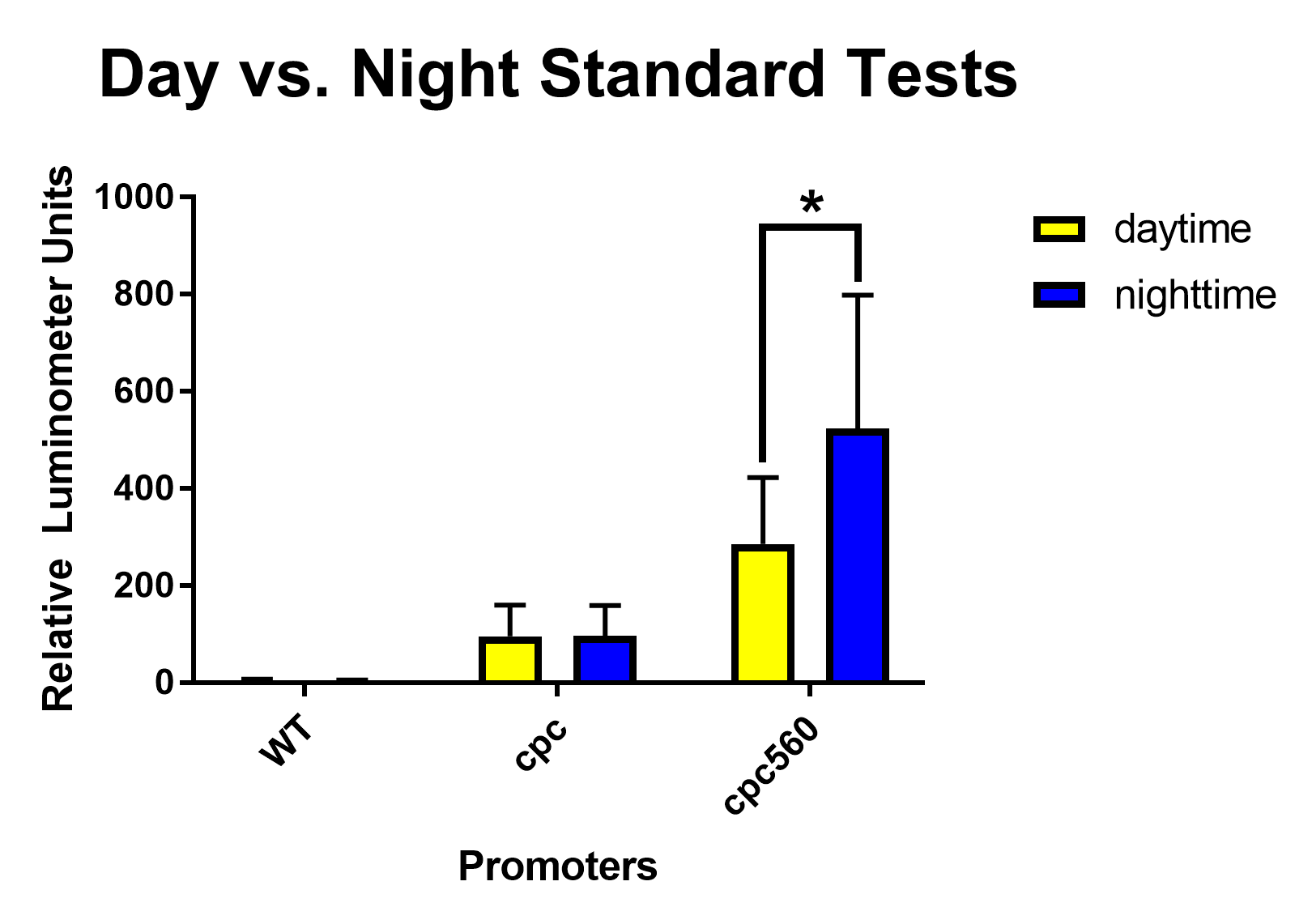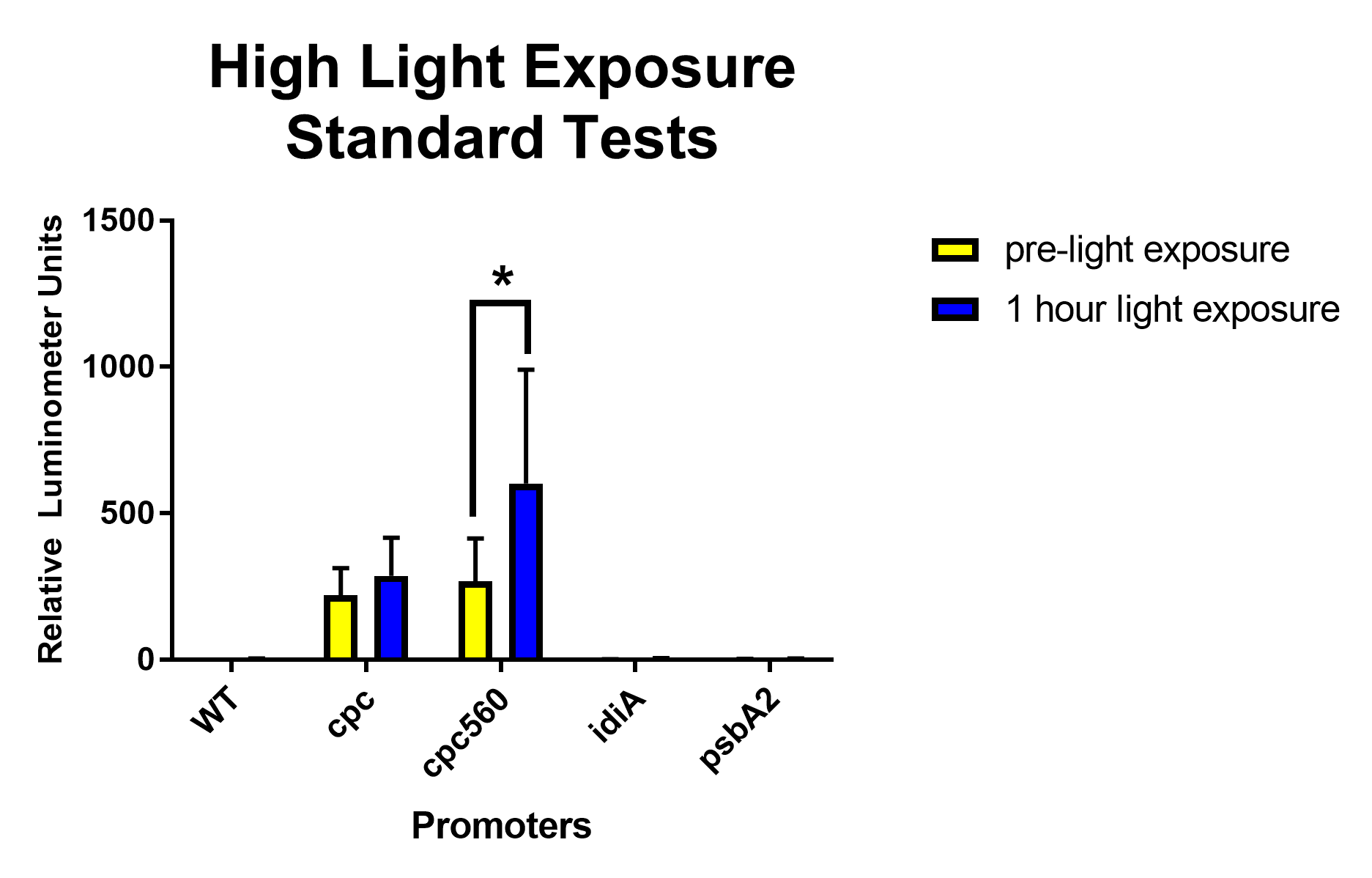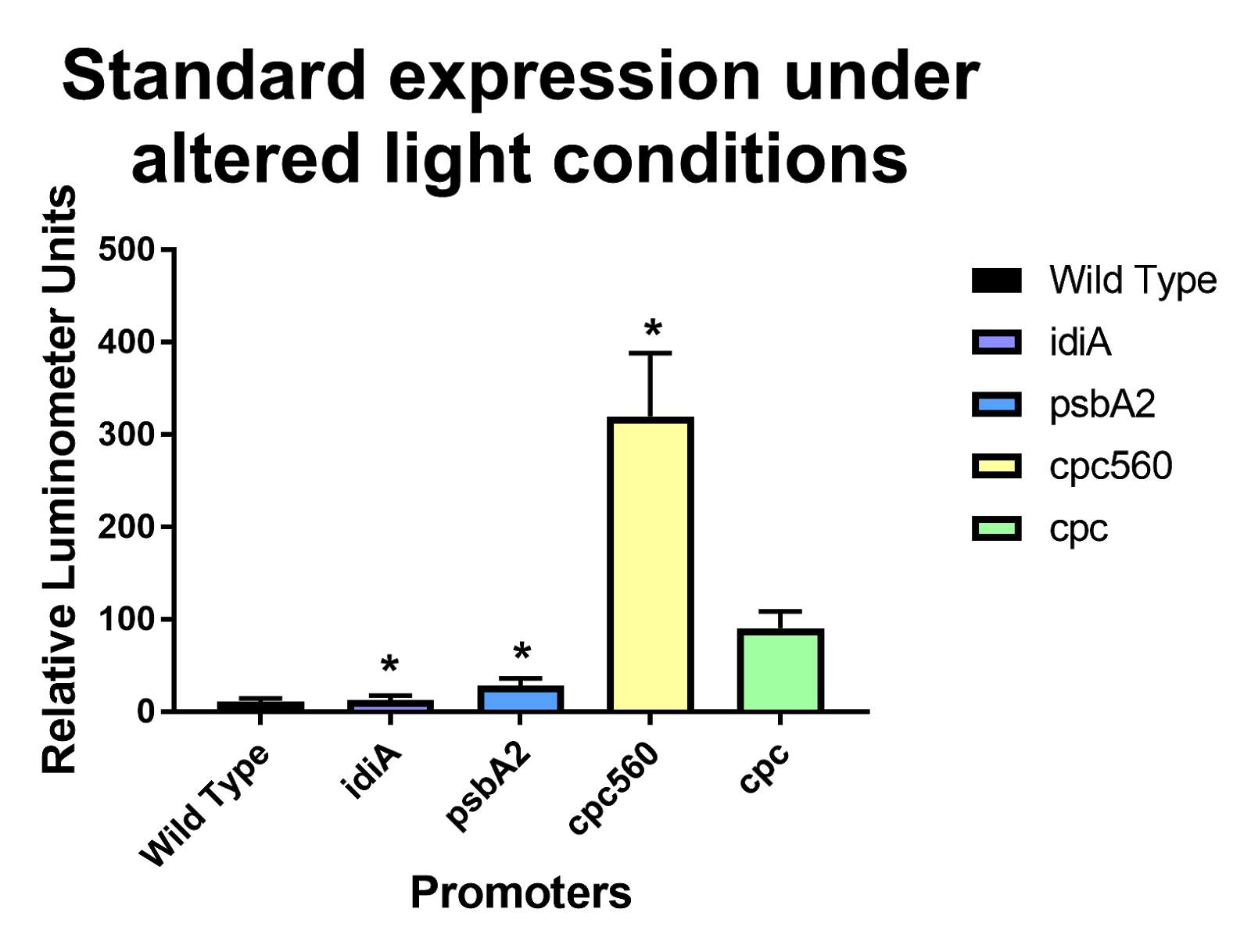Difference between revisions of "Part:BBa K2596006"
(→Luciferase Assays) |
(→Usage and Biology) |
||
| (8 intermediate revisions by 2 users not shown) | |||
| Line 3: | Line 3: | ||
<partinfo>BBa_K2596006 short</partinfo> | <partinfo>BBa_K2596006 short</partinfo> | ||
| − | This is a strong constitutive promoter from cyanobacteria Synechocystis sp. PCC 6803 | + | This is a strong constitutive promoter from cyanobacteria <i>Synechocystis</i> sp. PCC 6803 |
<!-- Add more about the biology of this part here --> | <!-- Add more about the biology of this part here --> | ||
===Usage and Biology=== | ===Usage and Biology=== | ||
| − | Pcpc-560 is a unique form of the Pcpc promoter native to Synechocystis sp. 6803. It includes the two cpc promoters (as described for Pcpc) and 14 | + | <i>Pcpc-560</i> is a unique form of the <i>Pcpc</i> promoter native to <i>Synechocystis</i> sp. 6803; however, it works in <i>Synechococcus elongatus</i> PCC 7942. It includes the two <i>cpc</i> promoters (as described for <i>Pcpc</i>) and 14 transcription factor binding sites, allowing it to be an incredibly strong promoter. It can be used to induce protein expression up to 15% total soluble protein in the cell [1]. |
| + | |||
| + | This promoter is much stronger than the constitutive promoter usually used Prbc. For example, our team had previously investigated but not experimented with alkane production. Dr. Xufeng Lu used the rbc promoter to induce alkane expression; however, cpc-560 is a much stronger promoter. Future iGEM teams could theoretically use this promoter and the alkane producing proteins to achieve much higher yields [2]. | ||
| + | |||
| + | References: | ||
| + | [1] Zhou J, Zhang H, Meng H, Zhu Y, Bao G, Zhang Y, Li Y, Ma Y. Discovery of a super-strong promoter enables efficient production of heterologous proteins in cyanobacteria. Sci Rep. 2014;4:4500. doi: 10.1038/srep04500. | ||
| + | |||
| + | [2] Weihua Wang, Xufeng Liu, and Xuefeng Lu. "Engineering cyanobacteria to improve photosynthetic production of alka(e)nes." Biotechnology for Biofuels20136:69 https://doi.org/10.1186/1754-6834-6-69. | ||
| + | |||
<!-- --> | <!-- --> | ||
<span class='h3bb'>Sequence and Features</span> | <span class='h3bb'>Sequence and Features</span> | ||
<partinfo>BBa_K2596006 SequenceAndFeatures</partinfo> | <partinfo>BBa_K2596006 SequenceAndFeatures</partinfo> | ||
| − | For the BioBrick, we kept the full 560 bp of Pcpc-560, and did not include an upstream region. The full cpc-560 promoter ends immediately before the ATG start codon in its native form. | + | For the BioBrick, we kept the full 560 bp of <i>Pcpc-560</i>, and did not include an upstream region. The full <i>cpc-560</i> promoter ends immediately before the ATG start codon in its native form. |
<!-- Uncomment this to enable Functional Parameter display | <!-- Uncomment this to enable Functional Parameter display | ||
| Line 27: | Line 35: | ||
[[File: T--Stony Brook--Results high light exposure.png|thumb|Figure 3. High light exposure Standard Expression tests for the constitutive promoters cpc and cpc-560, ferrous ion repressible idiA, and high light inducible psbA2 promoters]] | [[File: T--Stony Brook--Results high light exposure.png|thumb|Figure 3. High light exposure Standard Expression tests for the constitutive promoters cpc and cpc-560, ferrous ion repressible idiA, and high light inducible psbA2 promoters]] | ||
| + | |||
| + | [[File: T--Stony Brook--Results Effects of Iron Chelator.png|thumb|Figure 4. Effect of Iron Chelator on expression for the constitutive promoters cpc and cpc-560, ferrous ion repressible idiA, and high light inducible psbA2 promoters]] | ||
| + | |||
| + | [[File: T--Stony Brook--Results alternative light.png|thumb|Figure 5. Standard Expression tests under altered light conditions for the constitutive promoters cpc and cpc-560, ferrous ion repressible idiA, and high light inducible psbA2 promoters]] | ||
Experimental Methods: | Experimental Methods: | ||
| − | In order to test the expression of our promoters, cpc (BBa_K2596001), cpc560 (BBa_K2596006), idiA (BBa_K2596004), psbA2 (BBa_K2596003), which were incorporated into Dr. Susan Golden’s vector pAM1414 using Gibson assembly, we conducted luciferase experiments. Following Dr. Golden’s procedure, we added 5 µL of decanal to 95 µL of cyanobacteria in each well to induce expression. The decanal acted as a substrate for the bacterial luciferase enzyme, but due to the toxicity, the cells ended up dying, so the data obtained represents the end static expression. For the standard expression experiments for nighttime and daytime, we plated 95 µL of cyanobacteria into a 96 well plate, added 5 µL of decanal, parafilmed the edges and left the plate for 15 minutes before measuring the luminescence in a plate reader. For the | + | In order to test the expression of our promoters, <i>cpc</i> (BBa_K2596001), <i>cpc560</i> (BBa_K2596006), <i>idiA</i> (BBa_K2596004), and <i>psbA2</i> (BBa_K2596003), which were incorporated into Dr. Susan Golden’s vector pAM1414 using Gibson assembly, we conducted luciferase experiments. Following Dr. Golden’s procedure, we added 5 µL of decanal to 95 µL of cyanobacteria in each well to induce expression. The decanal acted as a substrate for the bacterial luciferase enzyme, but due to the toxicity, the cells ended up dying, so the data obtained represents the end static expression. For the standard expression experiments for nighttime and daytime, we plated 95 µL of cyanobacteria into a 96 well plate, added 5 µL of decanal, parafilmed the edges and left the plate for 15 minutes before measuring the luminescence in a plate reader. For the high light experiment to <i>psbA2</i> promoter, we plated 95 µL of cyanobacteria to half of the wells and put them under at least 500 µE of high light in our incubator for 1 hour. Then, we added 95 µL of cyanobacteria not exposed to high light to the other half of the wells and added 5 µL of decanal to all of the wells. Then, we placed the well plate in a plate reader and measured the luminescence. For the iron repressible experiment to <i>idiA</i> promoter, we plated 95 µL of cyanobacteria to half of the wells and exposed them to 2.3 mM of iron chelating agent 2,2-dipyridyl for one hour. Then, we added 95 µL of cyanobacteria not exposed to the iron chelating agent to the other half of the wells and added 5 µL of decanal to all of the wells. We placed the well plate in a plate reader and measured the luminescence. |
Results: | Results: | ||
| − | After removing outliers from the data set using the 1.5(IQR) rule and conducting unpaired T-tests assuming unequal variance, both cpc and cpc-560 showed significant differences for daytime expression compared to wild type [Figure 1]. Compared to cpc, cpc-560 had a significantly higher expression [Figure 1]. In comparison for day compared to night, cpc did not show any significant difference [Figure 2]. On the other hand, cpc-560 showed a significant difference between daytime and nighttime expression [Figure 2]. | + | After removing outliers from the data set using the 1.5(IQR) rule and conducting unpaired T-tests assuming unequal variance, both <i>cpc</i> and <i>cpc-560</i> showed significant differences for daytime expression compared to wild type [Figure 1]. Compared to <i>cpc</i>, <i>cpc-560</i> had a significantly higher expression [Figure 1]. In comparison for day compared to night, <i>cpc</i> did not show any significant difference [Figure 2]. On the other hand, <i>cpc-560</i> showed a significant difference between daytime and nighttime expression [Figure 2]. |
| + | After removing outliers from the data set using the 1.5(IQR) rule and conducting unpaired T-tests assuming unequal variance, for daytime expression, compared to all other promoters and the wild type, <i>cpc</i> and <i>cpc-560</i> had significant differences in expression [Figure 1]. For <i>idiA</i> and <i>psbA2</i>, they only had significant differences compared to cpc and cpc-560, and not to each other [Figure 1]. When exposed to highlight, <i>idiA</i> and <i>psbA2</i> did not show any expression [Figure 3]. | ||
| + | |||
| + | After removing outliers from the data set using the 1.5(IQR) rule and conducting unpaired T-tests assuming unequal variance, for expression after iron repression, <i>idiA</i>, <i>psbA2</i>, and <i>cpc-560</i> all showed a significant difference between before iron chelator reagent addition and after [Figure 4]. <i>cpc</i>’s insignificant difference could be attributed to the fact that there were only two cpc samples, as a result of insufficient cyanobacterial growth. The significant decrease in the expression of <i>cpc-560</i>, however, as a result of adding the iron chelator, indicates that the cells may have died from prolonged deficiency of ferrous ions, therefore that one hour may have been too long [Figure 4]. | ||
| − | + | When conducting our ferrous standard expression experiments, we had left the untreated cyanobacteria as well as the treated cyanobacteria in our biosafety cabinet, not expecting any major changes in expression due to the light exposure. However, under these light conditions, <i>psbA2</i> was expressed significantly more than wild type [Figure 5]. We propose that this may be due to our incubators having excess light intensity or red light, which may have inhibited <i>psbA2</i> expression. | |
Latest revision as of 01:03, 18 October 2018
Pcpc560 from Synechocystis sp. PCC 6803
This is a strong constitutive promoter from cyanobacteria Synechocystis sp. PCC 6803
Usage and Biology
Pcpc-560 is a unique form of the Pcpc promoter native to Synechocystis sp. 6803; however, it works in Synechococcus elongatus PCC 7942. It includes the two cpc promoters (as described for Pcpc) and 14 transcription factor binding sites, allowing it to be an incredibly strong promoter. It can be used to induce protein expression up to 15% total soluble protein in the cell [1].
This promoter is much stronger than the constitutive promoter usually used Prbc. For example, our team had previously investigated but not experimented with alkane production. Dr. Xufeng Lu used the rbc promoter to induce alkane expression; however, cpc-560 is a much stronger promoter. Future iGEM teams could theoretically use this promoter and the alkane producing proteins to achieve much higher yields [2].
References: [1] Zhou J, Zhang H, Meng H, Zhu Y, Bao G, Zhang Y, Li Y, Ma Y. Discovery of a super-strong promoter enables efficient production of heterologous proteins in cyanobacteria. Sci Rep. 2014;4:4500. doi: 10.1038/srep04500.
[2] Weihua Wang, Xufeng Liu, and Xuefeng Lu. "Engineering cyanobacteria to improve photosynthetic production of alka(e)nes." Biotechnology for Biofuels20136:69 https://doi.org/10.1186/1754-6834-6-69.
Sequence and Features
- 10COMPATIBLE WITH RFC[10]
- 12COMPATIBLE WITH RFC[12]
- 21COMPATIBLE WITH RFC[21]
- 23COMPATIBLE WITH RFC[23]
- 25COMPATIBLE WITH RFC[25]
- 1000COMPATIBLE WITH RFC[1000]
For the BioBrick, we kept the full 560 bp of Pcpc-560, and did not include an upstream region. The full cpc-560 promoter ends immediately before the ATG start codon in its native form.
Luciferase Assays
Experimental Methods:
In order to test the expression of our promoters, cpc (BBa_K2596001), cpc560 (BBa_K2596006), idiA (BBa_K2596004), and psbA2 (BBa_K2596003), which were incorporated into Dr. Susan Golden’s vector pAM1414 using Gibson assembly, we conducted luciferase experiments. Following Dr. Golden’s procedure, we added 5 µL of decanal to 95 µL of cyanobacteria in each well to induce expression. The decanal acted as a substrate for the bacterial luciferase enzyme, but due to the toxicity, the cells ended up dying, so the data obtained represents the end static expression. For the standard expression experiments for nighttime and daytime, we plated 95 µL of cyanobacteria into a 96 well plate, added 5 µL of decanal, parafilmed the edges and left the plate for 15 minutes before measuring the luminescence in a plate reader. For the high light experiment to psbA2 promoter, we plated 95 µL of cyanobacteria to half of the wells and put them under at least 500 µE of high light in our incubator for 1 hour. Then, we added 95 µL of cyanobacteria not exposed to high light to the other half of the wells and added 5 µL of decanal to all of the wells. Then, we placed the well plate in a plate reader and measured the luminescence. For the iron repressible experiment to idiA promoter, we plated 95 µL of cyanobacteria to half of the wells and exposed them to 2.3 mM of iron chelating agent 2,2-dipyridyl for one hour. Then, we added 95 µL of cyanobacteria not exposed to the iron chelating agent to the other half of the wells and added 5 µL of decanal to all of the wells. We placed the well plate in a plate reader and measured the luminescence.
Results:
After removing outliers from the data set using the 1.5(IQR) rule and conducting unpaired T-tests assuming unequal variance, both cpc and cpc-560 showed significant differences for daytime expression compared to wild type [Figure 1]. Compared to cpc, cpc-560 had a significantly higher expression [Figure 1]. In comparison for day compared to night, cpc did not show any significant difference [Figure 2]. On the other hand, cpc-560 showed a significant difference between daytime and nighttime expression [Figure 2]. After removing outliers from the data set using the 1.5(IQR) rule and conducting unpaired T-tests assuming unequal variance, for daytime expression, compared to all other promoters and the wild type, cpc and cpc-560 had significant differences in expression [Figure 1]. For idiA and psbA2, they only had significant differences compared to cpc and cpc-560, and not to each other [Figure 1]. When exposed to highlight, idiA and psbA2 did not show any expression [Figure 3].
After removing outliers from the data set using the 1.5(IQR) rule and conducting unpaired T-tests assuming unequal variance, for expression after iron repression, idiA, psbA2, and cpc-560 all showed a significant difference between before iron chelator reagent addition and after [Figure 4]. cpc’s insignificant difference could be attributed to the fact that there were only two cpc samples, as a result of insufficient cyanobacterial growth. The significant decrease in the expression of cpc-560, however, as a result of adding the iron chelator, indicates that the cells may have died from prolonged deficiency of ferrous ions, therefore that one hour may have been too long [Figure 4].
When conducting our ferrous standard expression experiments, we had left the untreated cyanobacteria as well as the treated cyanobacteria in our biosafety cabinet, not expecting any major changes in expression due to the light exposure. However, under these light conditions, psbA2 was expressed significantly more than wild type [Figure 5]. We propose that this may be due to our incubators having excess light intensity or red light, which may have inhibited psbA2 expression.





